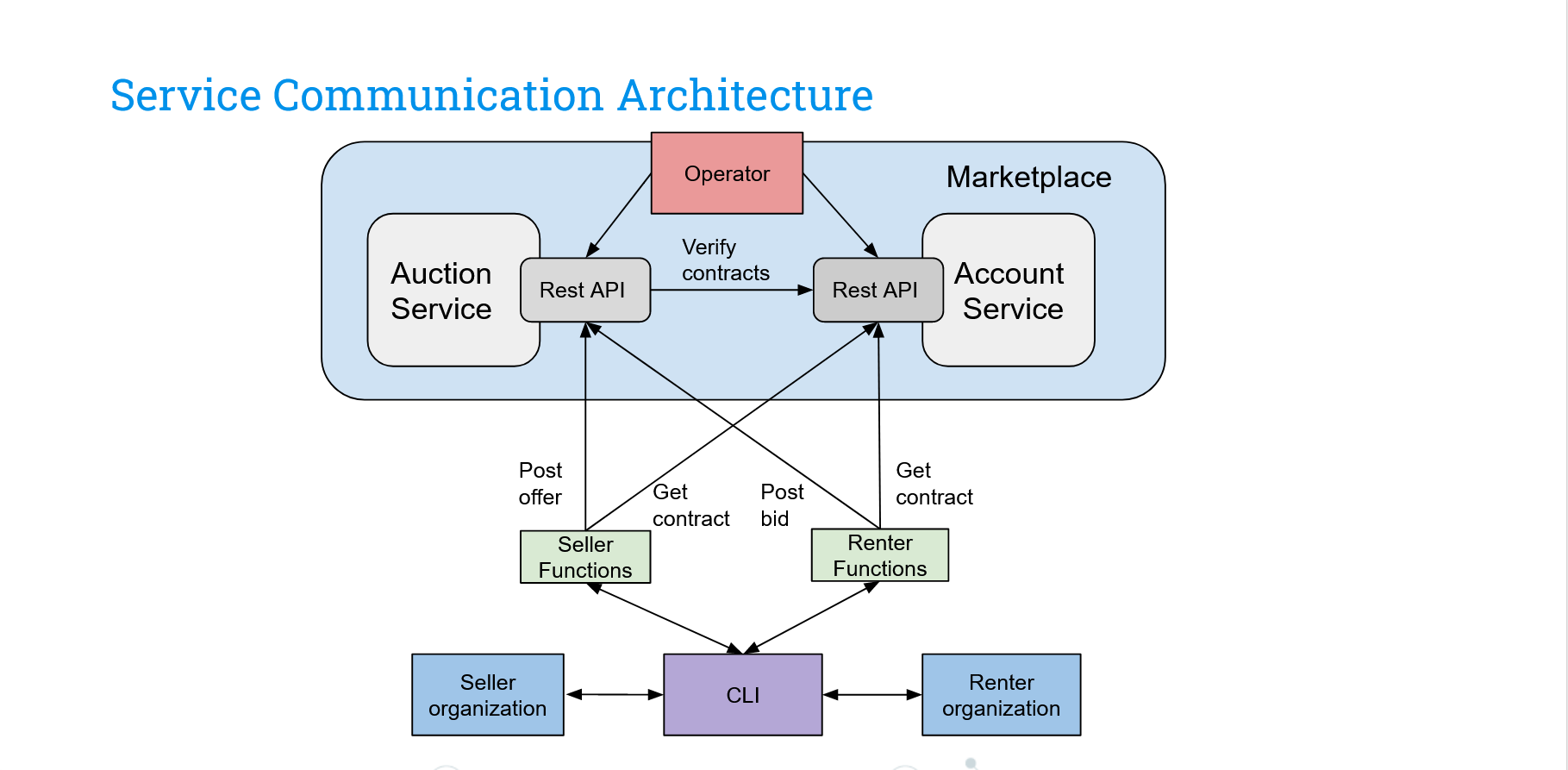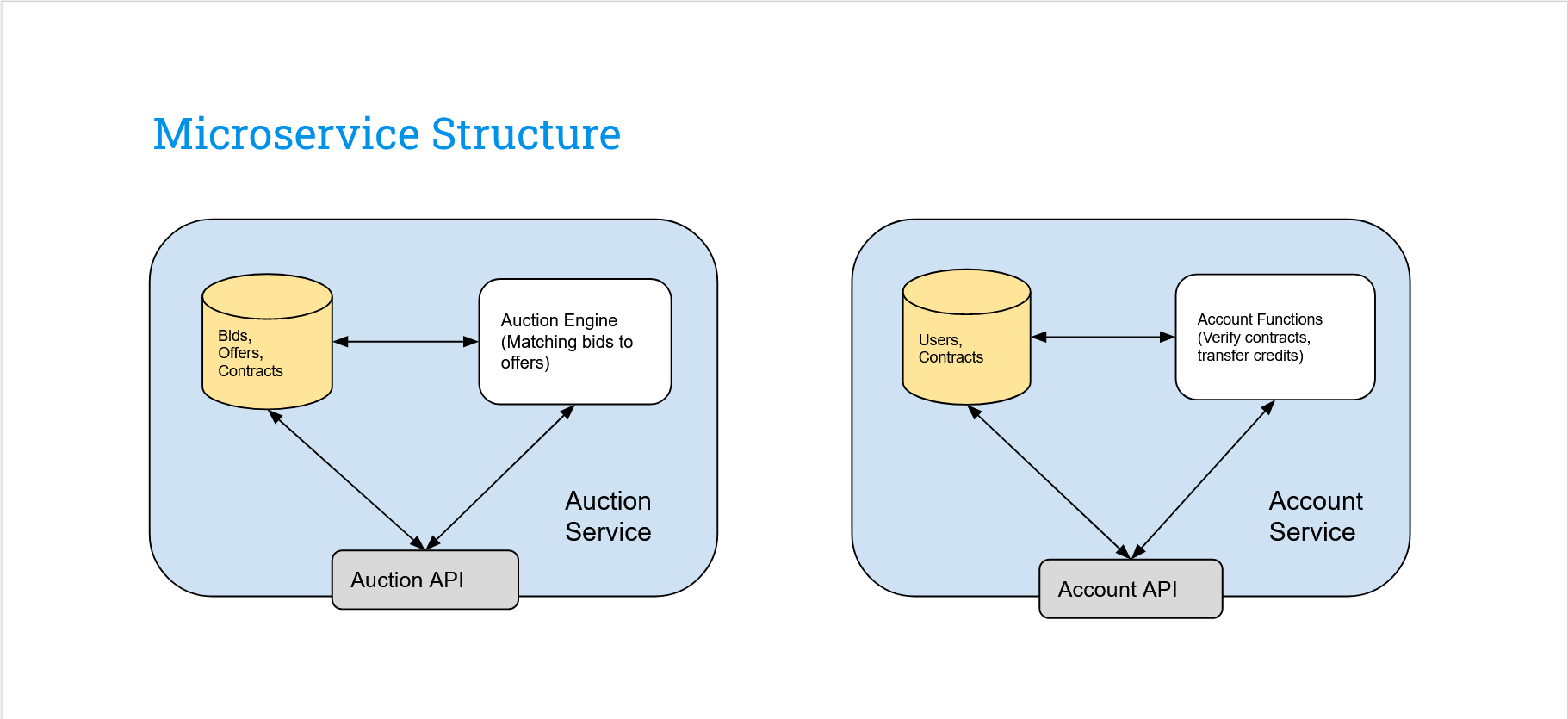Presentations:
- Many hosts do not use cloud servers due to multiple constraints including security, privacy, or a need for specific hardware. Hosts often rent space in a data center for their servers.
- In order to allow for scalability or temporarily increased resources and the opposite- productive use of unnecessary resources, a marketplace to buy and sell time on bare-metal nodes where a renter can use nodes for any purpose.
- Implementing an auction system in order to facilitate the fair economics of the bare-metal marketplace system.
- Adding a system for filtering based on resource
- Autobuy systems for HPC and temporary scaling purposes based on various criteria including cost per resource
- An enhanced UI
- Project Github
- Original FLOCX Marketplace
- Forked FLOCX Marketplace
- OpenStack Intro Docs
- Ironic Documentation
- Multi-Tenant Ironic
- MOC ESI
- KeyStone
- Bolted
There are 3 parts to setting up this project independently: Two servers (Market server and Account server) as well as user cli application.
On all of these, start by cloning the repo: git clone https://github.com/BU-CLOUD-S20/A-Bare-Metal-Marketplace
SERVER SETUP: Set up database for both account and auction services locally:
- sudo apt-get install mysql-server
- Go into mysql using: mysql -u root -p
- Create a new user: CREATE USER ‘username’@’localhost’ IDENTIFIED BY ‘password’; GRANT privileges ON . TO ‘username’@’localhost’;
- Create market and account database: Create database market; Create database account;
- Go to /database_setup/Models/marketModel and accountModel, use the user you just created in mysql and switch engine = create_engine("mysql+pymysql://username:password@localhost/market") with what we had in marketModel.py
- and switch engine = create_engine("mysql+pymysql://username:password@localhost/account") with what we had in accountModel.py
- Then run these two files to generate tables for market db and account db
Set up Flask and dependencies for both account and market services:
- Install Python3 and virtualenv on both servers
- “cd A-Bare-Metal-Marketplace/flaskapp” note: flaskapp/venv/bin/activate is included with installed dependencies but a separate environment and dependencies can be used as well
- Use “ipconfig” and find ip for both servers
- Modify account_url in flaskapp.py with the ip of account server
- Use “source venv/bin/activate” on both servers
- Run “python flaskapp.py” on market server and “python flaskAccount.py” on account server note: At this point server admin control can be tested with Postman or similar tools from a remote node note: Port 5000 is used for the marketplace and 5001 is used for the account. These ports must be open on the network
USER SETUP Set up CLI node
- Install python3 and virtualenv
- “cd A-Bare-Metal-Marketplace/CLI” note: CLI/venv/bin/activate is included with installed dependencies but a separate environment and dependencies can be used as well
- Modify bmm.py with the ip for the account and market servers
- “source venv/bin/activate”
- “python bmm.py --help” should output a list of commands
The vision of this project is an OpenStack service for data centers to implement an auction system for already written Bare Metal Marketplace technology in order to facilitate the rapid and secure trade of computing resources among DC tenants without physical interference. This tool has applications primarily in industry and in research contexts.
- Bare Metal Marketplace (BMM) will be a microservice in OpenStack which functions as a service auction for bare metal nodes.
High-Level goals of BMM include:
- Providing a simple straightforward user experience for non-expert users.
- Providing a command line interface (CLI) for streamlined access and implementation
- Enabling a direct P2P marketplace hosted by data centers.
BMM will be used by clients who sell resources, and clients who buy nodes on our marketplace.
-
Shared Data Center Operators: (OPs) OpenStack users that are interested in hosting marketplace services to tenants that do not create security issues. In charge of currency system etc. but should not have inside information on tenant nodes, only trivial information on offered nodes.
-
Hierarchy of Administrators: (Admins) Desire to control currency flow within hierarchy and assign roles/permissions to users below themselves in the hierarchy. Also have the option to modify projects and their connected servers, drive resources etc. May also be End Users.
-
Selling End Users: (Sellers) Desire this application to reduce the cost of ownership for resources not always needed- may have different reasons or times/amounts etc. of resources to rent.
- Type A- Wants to maximize money overall for a period of resource being rented
- Type B- Wants to maximize money per amount of time that resource is being rented
-
Buying End Users: (Buyers) Desire this application to obtain temporary additional resources from other tenants.
- Type X- Desire this application to quickly scale (industry)
- Type Y- Desire to run applications when cost-effective (HPC)
-
Currency-Using Developers: (Devs) As currency systems are new to OpenStack, developing the system in a secure way that can be shared by multiple applications is a desired goal.
Note that it is important to keep in mind DC tenants have some rationale for choosing a DC over cloud solutions, including security or specific resource needs.
The scope of this project is to design an auction system and related features- it is not to implement the core principles of the bare metal trading system. Included in this scope are UI elements related to the auction system, delivering information about nodes, selecting relevant resources based on cost, etc. Not included in this scope are cybersecurity aspects of bare metal access, delivery of the bare metal resource, etc.
- Hosting Tenants
- Addition/Management of nodes
- Authorization of who can sell
- Flexible contested node policy
- Multiple auction options
- True auction
- Buy now price set
- Analytics portal
- Renting Tenants
- Marketplace Filtering
- Data management / Hard drive connection
- All Users
- Messaging System
- Profile Pages
- Money Transfer / Credit System
Global Architectural Structure Of the Project:
Microservices and Communication Structure:
- CLI/UIs- Terminal and Web Clients for interacting with the system
- Multi-Tenant Ironic- Allows cross-organization bare metal node transfers
- OpenStack- Red Hat Cloud Computing Environment
- Keystone- Organization OpenStack based authentication
- Service Databases- Databases for administration and matching that are operator-owned
- Administration API- Connects to user control system to return administrative features
- Matching API- Connects to auction system to serve matches
The microservice itself needs to be light to run as to not consume unnecessary resources. Algorithmic steps for auction engine:
#import data
- Import bids from the database
- Import offers from the database
#select a bid to match 3. Select the bid with lowest expiry time and match with bids that have similar physical machine requirements 4. Eliminate the bids that do not have time overlap with the lowest expiry bid. The ones that do have a time clash are our clashing bids. 5. These clashing bids are sent to the second price auction selector, where the highest bid with its actual price of the bid is set as high_price and (price of second highest bid+0.01) is set as second_price
#select offer to match our selected bid 6. Eliminate all offers more expensive than the high_price of our selected bid 7. Select all offers whose offer time is part of the rental time of the selected bid. 8. The most expensive offer from these offers is selected to be matched to our bid 9. If the price of this offer is higher than the second_price, it is matched for bid price, if the price is less or equal to the second price, it is matched for the second price.
#contract creation and splicing of bids and offers 10. Create a contract and if the entire bid time was not fulfilled by the selected offer, create another bid for the remaining time. Vice versa, if the offer time of the matched offer is not fulfilled by the bid it matched to, create another offer for the remaining time.
Rinse and repeat till all bids or all offers have expired.
Minimum Criteria would be a simple auction system that could serve as the BMM. Stretch Goals Include:
- An autobuy system for renters
- Analytics pages
- Content Filtering
Week 3 goals:
- Implement simplified auction system in Python + test cases
- Create tests for base Ironic built in functionality
Week 5 goals:
- Learn about TDD, pytest, microservice
- Design auction system structure
- Create user stories for auction system
- Set up database with SQLAlchemy
Week 7 goals:
- Design micro service structure
- Write database queries using SQLAlchemy
- Implement Flask Rest APIs
- Connect handler to APIs
Week 9 Goals:
- Implement MVP auction engine
- Start working on account service
- Connect auction service and account service with API calls
- Start working on server deployment
Week 11 Goals:
- Integrate provider service with Ironic (Node provisioning) and publish as OpenStack service on MOC
- Implement CLI for POST/GET
- Robust Auction Engine Optimization
- Finish implementing account service
Week 13 Goals:
- Analytics / UI additional features + Profile features
#TODO all

